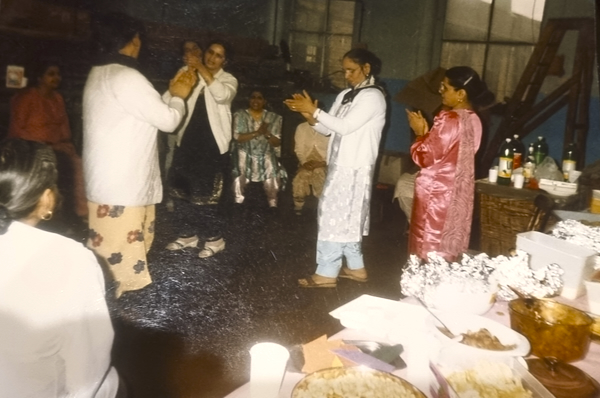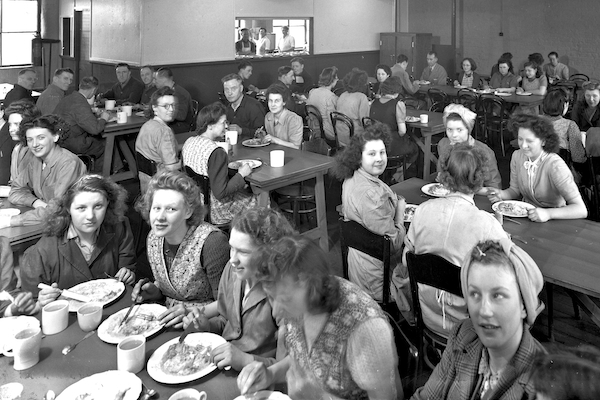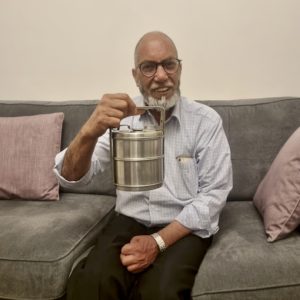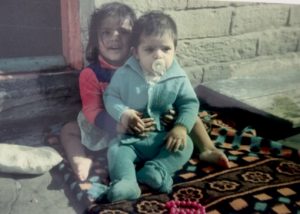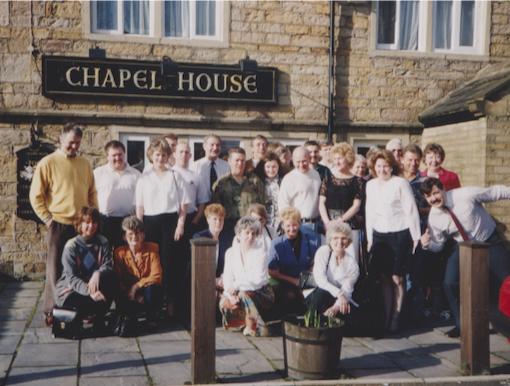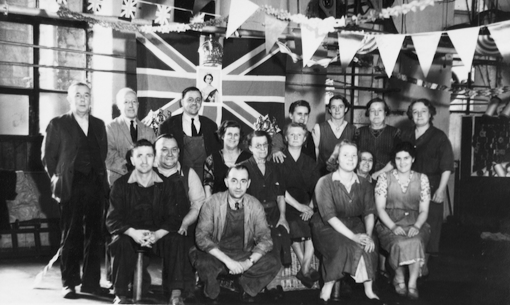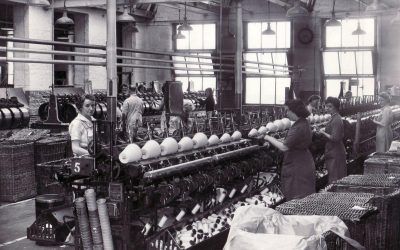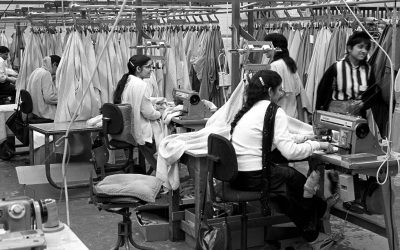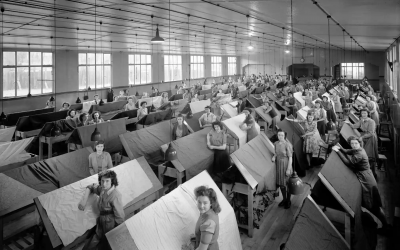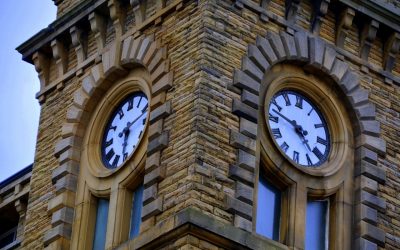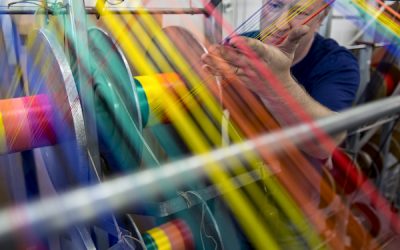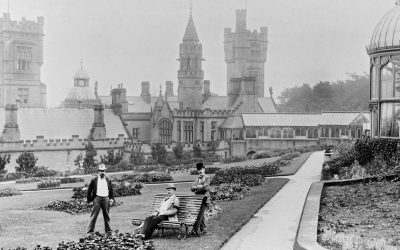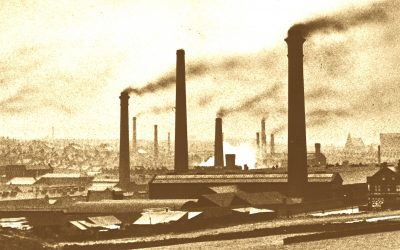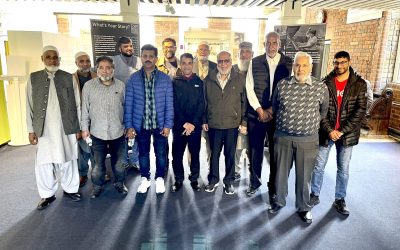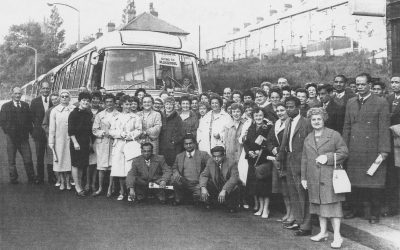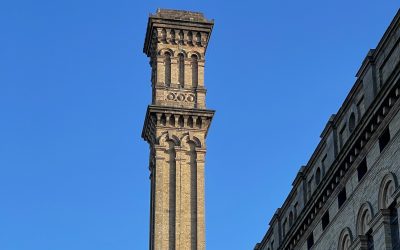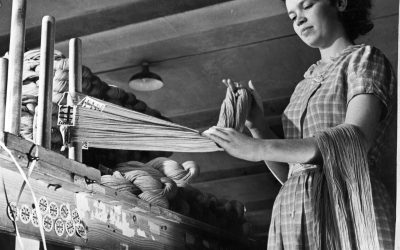In Saltaire there were lots and lots of foreign people. There were hundreds from Germany, Switzerland, and Italy, like me. Everyone there, in the hostel I stayed in, kept saying, ‘How do you grow spaghetti in Italy?’. So I made it up! We went to [the] shop. We bought a packet of spaghetti and put it in the ground. And then went on lifting it up a bit so it looked like it was growing. They believed it! We had to tell them. We explained to them – they laughed!
Food
Textile mills often had canteens, places where friendships were forged, gossip shared and romances sometimes began. For anyone working full time, meals were an important part of the working day and even more so for those on long shifts or night work.
Today, Bradford is billed as the ‘curry capital of England’ with curry houses and restaurants everywhere. But in the 1960s and 70s, Asian food was not so easy to come by and workers from Pakistan, India and Bangladesh found it difficult to find the food and spices they were accustomed to.
Many of the mill workers from overseas were young men who lived in shared houses. They would cook for one another in turn and if mill canteens did not provide Asian food, they would bring their own meals in a tiffin tin or find original ways to cook using steam pipes and hot lamps.
And what was a Christmas Fuddle? Check out Steve Gregson’s interview on this page.
Seasonal Socials at Smith Brothers & Foster’s
Trevor Keighley | Transcript
We used to have a Christmas meal out at the Craiglands Hotel in Ilkley, and then if it was really hot weather they’d organise, there used to be an ice cream van come up outside the mill and everybody got free ice creams it was absolutely a lovely, lovely, lovely place to work. A community, a lovely place to work, yeah.
Christmas Socials and Summer Pop at John Peel’s Mill (Baildon)
Julie Hirst | Transcript
We had Christmas parties. Well a couple of times we went to a hotel in Cleckheaton, but funnily enough, years later, my son and his wife got married, and we paid for the wedding reception and everything there. Same hotel, yeah, it was really weird. But we used to get a coach from Baildon, which the management set on. We all used to meet downstairs. We had a canteen and a kitchen. And a staff room at side, with [a] big table, and all oldies sat round the table. And us younger ones used to sit on [the] big pipes that were in the locker area. During summer, the management paid for me to go to Barracloughs on Westgate. Do you remember Barracloughs? The pop man? To get some cordials for us to have drinks during summer when it was really hot. ‘Cos it was like an oven up there.
Christmas Holidays
Roger Davy | Transcript
Christmas holidays weren’t very long. We would finish about 3 o’clock on Christmas Eve, and we’d have Christmas Day and Boxing Day, and be back the following day. And we didn’t stop for New Year’s Eve or New Year’s Day. Nowadays it’s fortnight off, basically. And there was none of that. But that wasn’t just us, that was Bradford. That’s the way it worked.
Naylor Jennings' Christmas Fuddle and Gifted Turkeys
Steve Gregson | Transcript
I didn’t actually work in the mill, but I was the lorry driver for them. And over the years I were doing it, I got to know them all. It was great. And I were actually invited to what they call…‘Would you like to come to the Christmas fuddle, Steve?’ Well, it were new to me. ‘What’s a fuddle?’ Basically, it’s a Christmas do that the workers have. And I were invited to go, which I thought were quite nice. So yeah…so I went to a couple of these fuddles over years, and it were great. And as an aside to that, the managing director bought every… I mean, there were two or three hundred worked in that mill. And the managing director actually bought a turkey for every member of the mill, for Christmas. And I had the, well, pleasure of going down to frozen food place to pick two or three hundred frozen turkeys up to bring back for them to distribute to the mill workers. And I actually got one. It was brilliant.
Growing Up
Fifty years ago textile mills were a big part of growing up in Bradford and any families could see a mill chimney from their home. Parents and relatives often walked to work and it was common to see children playing around the mill grounds. Sometimes they would play inside the mill whilst their parents worked, which would be considered totally unsafe today. It was very common for children to follow in their parents’ footsteps and get a job in the mill as soon as they left school or college.
Some mills hosted family events over Christmas, and Listers Mill had its own theatre for performances and pantomimes. Black Dyke Mills had a brass band with classes for children and which regularly performed in the local area. Although the mill is now closed, the Black Dyke Brass Band is internationally famous to this day.
Meeting Santa in Manningham Mill
Allan Brack | Transcript
In this century, as opposed to the one where the big strike happened, I think there was quite a bit of welfare. And quite a lot of clubs and societies off… springing off from the mill. And one of them was this, you know, this theatre. So there was a theatre group in the mill. And we were there to meet Santa Claus. But I honestly thought I was in something huge. I couldn’t believe it years later when I saw this space, and how small it was!
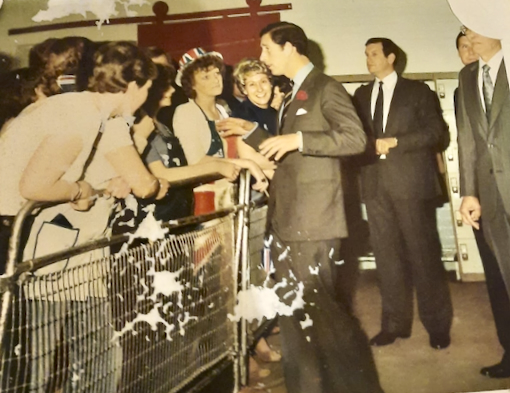
Photograph: Arshad Mahmood | Prince Charles visiting John Fosters, to see the fabric for Princess Diana's wedding dress.
When Prince Charles got married to Diana, he bought the material for his outfit from our factory, John Foster. He came down for a visit to see how it was made. We were all so excited. We lined up and he shook hands with us all.
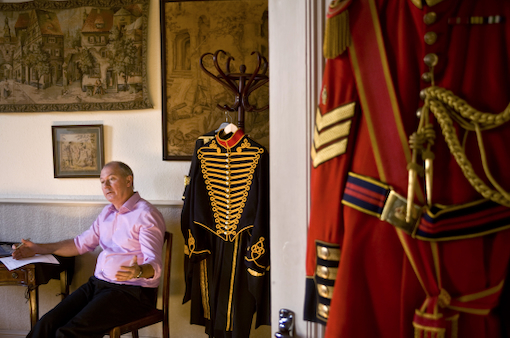
Photograph: Tim Smith | Robin Wright, the MD of Wyedean Weaving in Howarth, manufacturer of medal ribbons, braid and uniform accoutrement.
Cloth for the Queen
Roger Davy | Transcript
My great, well he wasn’t a… he was a very close courtesy uncle, worked for the head chief designer of T&M Bairdstow at Sutton, where my grandfather started work. And he worked his way up, a chap called Arthur Bottomley, to be head designer. And he had to create, I think twice a year, about 200 different designs. They were commissioned at T&M Bairdstow to create some dress cloth for the Queen when she was getting married to Prince Philip, in 1947, I think it was. Arthur, as head designer, did this. And my father used to say that he saw this cloth, and it was so fine – he wove it in with a very grey thread. But the wool thread was so fine that he had to twist it with some alginate, which is a seaweed derivative, to just give it a bit of strength during spinning and weaving. And then in the finishing process, the alginate would be washed out of the cloth. It was soluble, and you were just left with the woollen cloth. And Dad said, he saw this cloth, he said it was so fine, you could hardly feel it when you touched it, but it was so opaque you couldn’t see through it. And one of my father’s cousins who was a weaver there, she said to Dad one day, she said, ‘I wish that Arthur Bottomley would stay at home!’ Because she’d have this job of weaving this.
Working in Bradford’s textile industry was much more than just a job. Whole communities grew up around the mills. People from different backgrounds and generations lived and worked closely together, sharing leisure and play time. Mill owners and the workforce would organise trips and outings, with seasonal celebrations for Christmas and summer holidays.
The mill and the community around it was a way of life, with social clubs, sports and arts associations, schools, surgeries, corner shops and playgrounds. When the mills began to close, community ties began to loosen and people moved on, but for many a deep sense of belonging still remains.
Canteens at W & J Whitehead’s Old Mill
Kim Sharp | Transcript
When I worked at Whitehead’s, I worked in what they called the New Mill. So they had a little canteen there. It was just machines, you know, giving you sandwiches and drinks. But in the Old Mill, that’s where you got proper food cooked. So sometimes I’d go over there and leave my workmates to chatter. And I’d have a decent meal over there if I was starving. The good thing about working two while half past nine is I got to have a lie in bed. Because I didn’t have to get up early to go to work.
Most mills had a canteen, but at nights we took chapatti and curry. The machines had a very strong bulb with a mirror that reflected the threads, so we knew which one was broken to fix it. It was very hot too, so we placed our tiffin’s near the bulb and within half an hour the food would be hot and ready to eat.
Our dinner was for 45 minutes between 12-12.45 and then we had tea at 4am. We had an oven at work and I often took in chicken, marinated them outside on the cold steps and then put them in the oven to slowly cook as we worked. I’d invite the overlookers and managers to join us. Once I took in a leg of lamb, but didn’t know how long it would take. I marinated and put it in at 11pm. It wasn’t ready till 4am! On the weekends I used to take the orders, pop out and get fish and chips for everyone. We had a good time.
Trips & Treats
Mill workers and their families would get together and organise outings and events. Sometimes it would be a fancy meal in a posh hotel in Ilkley, other times a coach trip to the seaside or even that London town! Bollywood films in the centre of Bradford became popular, particularly with men who had families overseas. Holiday times were precious and people would save up throughout the year in order to pay for a week or two away. Morecambe was a favourite with Bradford mill workers and became known as Bradford by the Sea. It had daily deliveries of the Bradford Telegraph and Argus newspaper so that folk could keep up with what was happening back home.
Our dinner was for 45 minutes between 12-12.45 and then we had tea at 4am. We had an oven at work and I often took in chicken, marinated them outside on the cold steps and then put them in the oven to slowly cook as we worked. I’d invite the overlookers and managers to join us. Once I took in a leg of lamb, but didn’t know how long it would take. I marinated and put it in at 11pm. It wasn’t ready till 4am! On the weekends I used to take the orders, pop out and get fish and chips for everyone. We had a good time.
My dad were a chimney sweep and we used to go to Black Dyke Mills to clean the boilers, when the school holidays and that were on. So we used to clean the boilers and we had the place to ourselves when the holidays were on. And we had to clean out all these little tubes inside the boilers, with brushes and that.
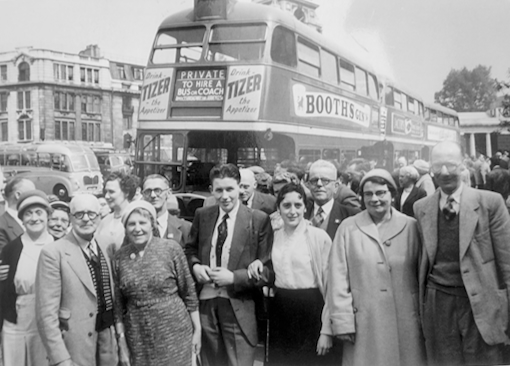
Photograph: Patricia Crabtree | Harold Heppleston, Patricia's Father, and Colleagues from Kellett Woodman
Playing in Bradford's Mills
Jaz Oldham | Transcript
We were surrounded by them because we grew up on Bilton Place. It’s off City Road, opposite what used to be Narang’s Mill. You could see the mills from there. There was an aluminium mill, which used to have like a little cave underneath. And we used to go and play there, in the little cave. There was some water there. When that aluminium mill…factory closed, I know it wasn’t a textile mill, but it was a mill, and it was there. We actually used to go in there [lowers voice] and we used to jump out of windows, and we used to play in there. I don’t know if mum and dad really knew that we did that. Up there by the side of where… up behind there by where Globe Warehouse is… I think that might be in a different location now….We just used to play there, there was just like, we’d just go and play on a bit of land that was there. Just doing what kids do…handstands, playing a bit of football…And they were just there and we would just play around them.
When we were kids, we’d best of everything. We’d all Marriner’s ground to play in, the car park. We’d work with a [it were a] rough car park, all the jungle around the back of it. And where Fernside’s foundry was were down, well Victoria Street here and Fernside’s went down here and down here. Well on this side, they’d all big doors where they got all the sand up for moulding. Well, that used to seep under the door, so we had us own beach down that street. You couldn’t have lived in a better place in them days for playing.
Things to do...

As you can see, it wasn’t all work with no play in textile mills! These jobs allowed workers to support their families, buy property, make friends, learn English, and visit new places with the seaside daytrips organised by mill owners. To further your learning, here are more activities to explore:
What to do next...
Listen to Abdul Ghafor’s full interview on the archive to discover the unique hobby he enjoyed from his textile mill wages!
What to do next...
How far is it to a seaside town from Bradford? Imagine you’re on a mill trip and write a diary entry describing your outing. You could even draw a picture!
Discover More
Lost Mills
Lost Mills & Ghost Mansions
Photograph: Tim Smith | UNSPUN How To Use The Learning Zone is a rich and fascinating resource for all. Take your time to explore and discover the many stories and insights on offer. Whether you are a student, a teacher, a researcher, a community group or an...
Working life
Photograph: Tim Smith | Lifting hanks of wool from a dyeing vat at Harrison Gardner and Company. If you've seen old mills, pictures of old mills and that, you'll see that there's a big mill with five or six storeys. And then at the back of it, probably, there's a one...
Diverse workforce
Photographs: Bradford Museums & GalleriesBackground: Bradford Museums & Galleries Photograph: Tim Smith | Combing at Haworth Scouring CompanyBackground: Bradford Museums & Galleries Photograph: Jaz Oldham | Jaz's Sister and Friend working in the mill The...
Rights & Wrongs
Photograph: Val Rowland | Anwar Hussain (L), Bill Morris, former General Secretary of the Transport and General Workers Union (C), and Muhammad Rasab (R). Representing the racial discrimination case against John Haggas Ltd onstage at the Trade Union Annual Congress...
Changing Ways
Photographs: Mark Stevenson | Dalton Mill and Clock Tower I could see at that time that the mills were starting to close around Keighley all over the town and I thought ‘I need to be moving on somewhere’ and that's when I left in 1975 and joined the fire service....
Textiles Today
Background Photograph: Tim Smith | Laxtons' state-of-the-art spinning machinery in Baildon Title Photograph: Tim Smith | Weaving of Rainbow Ribbons at Wyedean Weaving in Haworth In 2022, I saw this job. And I rang them up and said ‘I’m looking for a job as a...
Ghost Mansions
I know that Robert Clough - he had a big mansion, and he donated a Christmas tree for the people of Keighley one year. Well, I won't be swayed on this at all. Particularly on a Friday night, when everybody else had gone home,...
Research & Map
Background Photograph: Bradford Museums & Galleries | Bradford's Skyline Title Photograph: Rainbow School | Visiting Bradford's Industrial Museum I grew up next to Marriner’s and I actually watched it burn down. It would have been in the ‘70s. I was in my...
Do It Yourself
Photograph: Alan Dix | Sangat Centre at Bradford Industrial Museum I think what people should do is show an interest in local history because one day (and I hope this never happens) there won’t be people like you, and there won’t be people like me, who...
Mediawall
Photograph: Margaret Dobson via Keighley and District Local History Society | Employees of John Haggas Ltd's Outing to Blackpool Lost Mills Media Wall Here we celebrate the rich visual history shared by contributors and project partners whilst researching Bradford's...
Archive
Photograph: Alan Dix | Lister's Mill ChimneyWelcome to the Lost Mills Archive. Here you will find all the recordings and transcripts that have been made during the lifetime of the project. It contains a wealth of information - far more than we could ever use in the...
Contributors
Thank you Lost Mills and Ghost Mansions has involved at least 500 people one way or another and their support, participation and commitment has taken us on a very special journey. Most of the people we interviewed were in their 70s and 80s and some were over 90. It is...
The contents of the 509 Arts website are protected by copyright unless otherwise stated. The Lost Mills Learning Zone recordings, text and activity suggestions are free to use for non-commercial community and education purposes. If you wish to use the materials for any other purpose, email info@509arts.co.uk with your plans.
Some of the images and video footage belong to a third party and are credited as such. If you wish to use any such content, please contact 509 Arts or the copyright owner directly.

